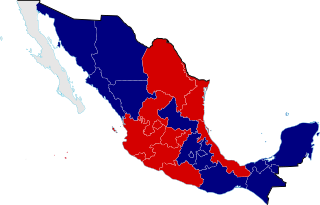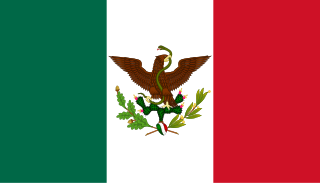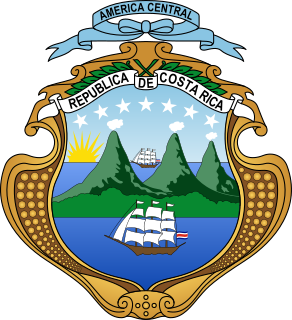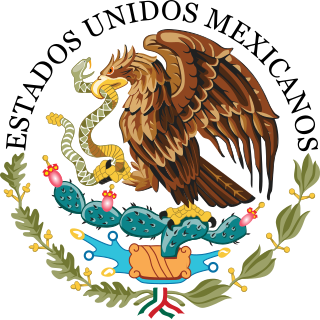
The United Mexican States is a federal republic composed of 31 states and the capital, Mexico City, an autonomous entity on par with the states.

Benito Pablo Juárez García was a Mexican lawyer and president of Mexico, of Zapotec origin from Oaxaca.

Venustiano Carranza Garza was one of the main leaders of the Mexican Revolution, whose victorious northern revolutionary Constitutionalist Army defeated the counter-revolutionary regime of Victoriano Huerta and then defeated fellow revolutionaries after Huerta's ouster. He secured power in Mexico, serving as head of state from 1915–1917. With the promulgation of a new revolutionary Mexican Constitution of 1917, he was elected president, serving from 1917 to 1920.

Sebastián Lerdo de Tejada Corral was a jurist and Liberal president of Mexico, succeeding Benito Juárez who died of a heart attack in July 1872. Lerdo was elected to his own presidential term later in 1872 rather than remaining successor due to his previous office of Chief Justice of the Supreme Court. Juárez's political rival liberal General Porfirio Díaz had attempted a coup against Juárez, but his Plan de la Noria failed and Díaz was eliminated as a political foe during Lerdo's 1872-76 term, giving Lerdo considerable leeway to pursue his program without political interference. Lerdo was more successful than Juárez in his final years as president in pacifying the country and strengthening the Mexican state. He ran for another term in 1876 and was elected, but was overthrown by Porfirio Díaz and his supporters under the Plan of Tuxtepec, which asserted the principle of no-reelection to the presidency. Lerdo died in exile in New York in 1889, but Díaz invited the return of his body to Mexico for burial with full honors. Not counting Miguel Miramón, an unrecognized president during the Reform War, he is the first president of the recognized presidents that was not born during Spanish colonial rule.

Elections in Zambia take place within the framework of a multi-party democracy and a presidential system. The President and National Assembly are simultaneously elected for five-year terms.

The Congress of the Republic of Peru is the unicameral body that assumes legislative power in Peru. The congress consists of 130 members (congresistas), who are elected for five-year periods in office on a proportional representation basis.

The War of Reform in Mexico, during the Second Federal Republic of Mexico, was the three-year civil war between members of the Liberal Party who had taken power in 1855 under the Plan of Ayutla, and members of the Conservative Party resisting the legitimacy of the government and its radical restructuring of Mexican laws, known as La Reforma. The War of the Reform is one of many episodes of the long struggle between Liberal and Conservative forces that dominated the country’s history in the 19th century. The Liberals wanted to eliminate the political, economic, and cultural power of the Catholic church as well as undermine the role of the Mexican Army. Both the Catholic Church and the Army were protected by corporate or institutional privileges (fueros) established in the colonial era. Liberals sought to create a modern nation-state founded on liberal principles. The Conservatives wanted a centralist government, some even a monarchy, with the Church and military keeping their traditional roles and powers, and with landed and merchant elites maintaining their dominance over the majority mixed-race and indigenous populations of Mexico.

A constitutional referendum was held in Bolivia on 25 January 2009, postponed from the initially planned dates of 4 May 2008 and then 7 December 2008. Drafted by the Constituent Assembly in 2007, the new constitution was approved in the referendum according to an exit poll by Ipsos Apoyo for La Razón and ATB, a Bolivian television network. Furthermore, it required early elections to be held on 6 December 2009.

A constitutional referendum was held in Chile on 30 June 1989. The proposed changes to the constitution were approved by 91% of voters.
In Mexican history, the Plan of Tuxtepec was a plan drafted by Porfirio Díaz in 1876 and proclaimed on 10 January 1876 in the Villa de Ojitlán municipality of San Lucas Ojitlán, Tuxtepec district, Oaxaca. It was signed by a group of military officers led by Colonel Hermenegildo Sarmiento and drafted by porfiristas Vicente Riva Palacio, Irineo Paz, and Protasio Tagle on the instigation of Díaz. Díaz signed the previous version of the plan in December 1875, which did not include the three most important articles that appointed Diaz as president. It disavowed Sebastián Lerdo de Tejada as President, while acknowledging the Constitution and the Reform laws, and proclaimed Díaz as the leader of the movement. Díaz later became the president of Mexico.

The Congress of People's Deputies of the Russian SFSR and since 1991 Congress of People's Deputies of the Russian Federation was the supreme government institution in the Russian SFSR and in the Russian Federation from 16 May 1990 to 21 September 1993. Elected on 4 March 1990 for a period of five years, it was dissolved by presidential decree during the Russian constitutional crisis of 1993 and ended de facto when the Russian White House was attacked on 4 October 1993. The Congress played an important role some of the most important events in the history of Russia during this period, such as the declaration of independence of Russia from the USSR, the rise of Boris Yeltsin, and economic reforms.

The Moldovan referendum of 2010 was a nationwide referendum in Moldova held on 5 September on whether or not the country should amend the Constitution of Moldova to return to direct popular election of the president. Since 2001, the president had been indirectly elected by Parliament, with a supermajority of 61 seats required for election.. The voters are asked to answer the following question "Would you agree with the Constitutional amendment, which would allow the election of the President of the Republic of Moldova by the entire population?", voting for one of the proposed options: “Yes (for)” or “No (against)”. Of those who had cast their vote, 87.83% chose "Yes". However, the referendum did not pass because only 30.29% of voters turned out, short of the necessary 33% for the referendum to be considered valid.

The Federal Constitution of the United Mexican States of 1857 often called simply the Constitution of 1857 is the liberal constitution drafted by 1857 Constituent Congress of Mexico during the presidency of Ignacio Comonfort. It was ratified on February 5, 1857, establishing individual rights such as freedom of speech; freedom of conscience; freedom of the press; freedom of assembly; and the right to bear arms. It also reaffirmed the abolition of slavery, eliminated debtor prison, and eliminated all forms of cruel and unusual punishment, including the death penalty.

The Second Federal Republic of Mexico is the name given to the second attempt to achieve a federalist government in Mexico. Officially called the United Mexican States, a federal republic was implemented again on August 22, 1846 when interim president José Mariano Salas issued a decree restoring the 1824 constitution. Like the Mexican Empire, the First Federal Republic and the Centralist Republic it was a chaotic period, marked by political instability that resulted in several internal conflicts. Mexico's loss of the war with the United States saw half the territory Mexico claimed become part of the United States. Even though Antonio López de Santa Anna played a major role in much of this history, he returned to the presidency yet again, selling northern territory coveted by the United States contiguous to territory it just gained in the Treaty of Guadalupe Hidalgo. The sale of the Mesilla Valley was for many the final straw, and liberals promulgated of the Plan of Ayutla, calling for the overthrow of Santa Anna. Santa Anna went into exile and the liberals set about implementing their vision of Mexico.

A referendum on electing a Constitutional Assembly was held in Colombia on 27 May 1990 alongside presidential elections. The proposal was approved by 96% of voters. A Constitutional Assembly was later elected in December 1990 and produced the 1991 constitution.

Parliamentary elections were held in Colombia on 11 March 1990 alongside local elections and an unofficial referendum on electing a Constitutional Assembly.

Constitutional Assembly elections were held in Colombia on 9 December 1990 alongside a referendum on the Assembly itself. The Assembly sat from February to July 1991 and drew up the 1991 constitution.

The Constitution of Costa Rica is the supreme law of Costa Rica. At the end of the 1948 Costa Rican Civil War, José Figueres Ferrer oversaw the Costa Rican Constitutional Assembly, which drafted the document. It was approved on 1949 November 7. Several older constitutions had been in effect starting from 1812, with the most recent former constitution ratified in 1871. The Costa Rican Constitution is remarkable in that in its Article 12 of the Constitution of Costa Rica abolished the Costa Rican military, making it the second nation after Japan to do so by law. Another unusual clause include an amendment asserting the right to live in a healthy natural environment.

A constitutional referendum was held in Armenia on 6 December 2015. Its amendments to the constitution put the country on a course from having a semi-presidential system to being a parliamentary republic, with the changes beginning to take place during the 2017–18 electoral cycle. The referendum passed with 66.2% of voters supporting it. Voter turnout was 50.8%, passing the 33% threshold to validate the results.

A constitutional referendum was held in Peru on 9 December 2018 alongside the second round of gubernatorial elections.






















